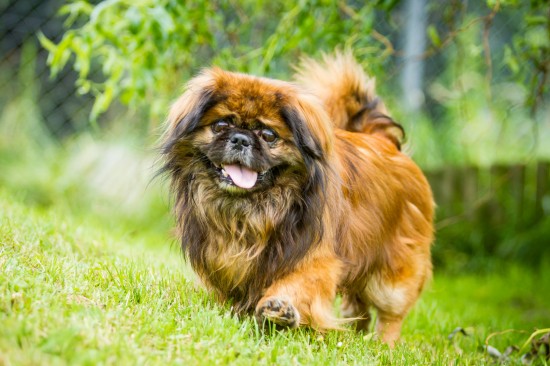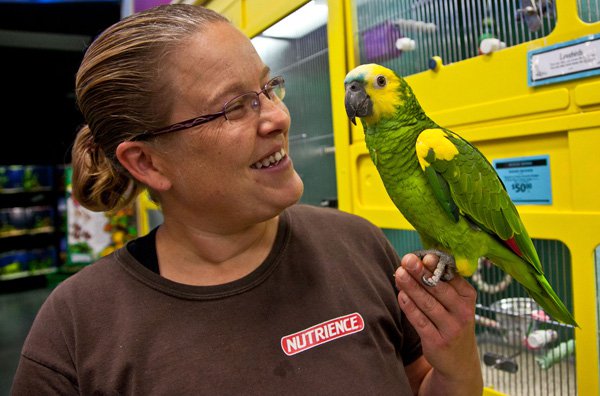
There are many styles of collars to choose from depending upon your dog’s size, disposition, as well as your personal needs. For many dogs, a traditional nylon or leather collar will suffice. However, there are collars for more specific situations as described below.
Traditional Collars: Traditional collars are available in numerous colors, styles, and widths. These collars should ride higher on your pet’s neck. Don’t use collars that are too loose, falling down towards your pet’s shoulder blades. When choosing a collar use a tape measure to determine your pet’s neck size, adding about two to three inches to insure proper fit.
When choosing a collar make sure it is snug allowing enough room to fit two fingers between your pet’s neck and their collar. For safety reasons, a collar should never be loose enough to slip over the pet’s head. The risk of losing a pet that slips away can increases when their collar is too loose. Also, loose collars may easily snag on objects, increasing the risk of accidental hanging and other trematic injuries as a result of being entangled due to loose collars. In addition it is important that collars are not worn in wire cages. Be sure your pet’s collar is not too tight which can restrict their breathing or cause coughing. Make sure you check the collar size frequently with your puppies.
Choose a collar and lead with the appropriate width that matches your pet’s size. Smaller, lightweight collars and leads are for small dogs and puppies, while wider, more durable styles are for larger, stronger pets.
Be sure you have a current nametag attached to your pet’s collar at all times.
Harnesses: Harnesses, will go around the neck and around the shoulders behind the front legs, are generally recommended for dogs who have upper respiratory disease as well as diseases of the throat or trachea. If a collared dog pulls on their leash, it places pressure on the throat and trachea, which can cause irritation and coughing. Harnesses are an excellent choice to help relieve that pressure.
Halter Collars ensure the best control over your dog. Giving you control of your dog’s head. Controlling your dog’s head, gives you control of your dog. Many brands of halter-type collars are available including the Halti Training Headcollar. These collars have a band that goes around the back of their head, and another band around their nose. These leashes snap onto the collar under the dog’s chin. When pulling on the leash, your dog’s head will pull down or to the side, makeing it next to impossible for your dog to move ahead or pull you forward.
Slip (Choke) Collars: Slip collars, also called “choke collars,” provide effective training and retraining methods when used correctly. Many times these collars are used for dogs whom are stubborn, pull when lead, or for those that do not respond well to training when wearing other collars.
If you need to use a choke collar, make sure you how to use it correctly. If not, have a trainer assist you in demonstrating its proper use. Using a choke collar correctly involves a quick ‘tug-and-release’ action which tells your pet a different behavior is desired. Only utilize these collars when training, making sure it is not worn in a crate, while avoiding use on pets with delicate tracheas.
Prong Collars: Prong Collars contain blunt prongs that face inward from the collar links. Designed solely for the most stubborn of pullers, they are a temporary training tool designed to change behavior on dogs that do not respond to any other type of collar. Unfortunate if they are necessary, we’ve found it best to make sure your training methods are being utilized correctly, which at times can eliminate the need to use this type of collar. However, there are situations and/or dogs that may require this type of collar, to insure the training is as effectual as possible.
Mike Steele
http://www.dog.com
 Pekingese Dog Hereditary Health And Health Testing
Pekingese Dog Her
Pekingese Dog Hereditary Health And Health Testing
Pekingese Dog Her
 Cat Feeding Tips From The Experts
Cat Feeding Tips
Cat Feeding Tips From The Experts
Cat Feeding Tips
 Information on bull terrier puppies
Information on bull terrier puppies
Bull terri
Information on bull terrier puppies
Information on bull terrier puppies
Bull terri
 Bullmastiff Health And Temperament
Bullmastiff Healt
Bullmastiff Health And Temperament
Bullmastiff Healt
 Why Proper Dog Grooming Session is Important for Every Dog?
Why Proper Dog Grooming Session is Important for Every Dog
Why Proper Dog Grooming Session is Important for Every Dog?
Why Proper Dog Grooming Session is Important for Every Dog
Copyright © 2005-2016 Pet Information All Rights Reserved
Contact us: www162date@outlook.com